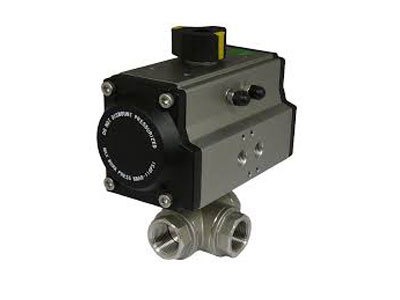What Is A 4-Way Pneumatic Valve?
Key Takeaway
A 4-way pneumatic valve is a crucial component in pneumatic systems that control the motion of actuators, such as cylinders or motors. It is a directional control valve that helps regulate air flow to operate double-acting cylinders and bi-directional air motors. The valve typically has four or five ports and provides four distinct flow paths, enabling efficient control of air direction.
The operation of a 4-way valve involves using two 3-way valve functions simultaneously—one that is normally closed and another that is normally open. This allows for the reversal or precise control of motion in a pneumatic system. 4-way valves are widely used in applications that require higher air pressure and complex movement, playing an essential role in industrial automation and air circuitry.
Design and Features of 4-Way Pneumatic Valves
A 4-way valve is constructed with four key ports: the supply port, which receives compressed air, two actuator ports that control motion, and an exhaust port for releasing excess air. Internally, it features a spool or poppet mechanism that redirects airflow between these ports.
The valve can be manually, electrically, or pneumatically actuated, allowing flexibility in operations. Materials like aluminum or stainless steel ensure durability and resistance to wear, even in harsh environments.
Additional features include seals to prevent air leakage and springs to return the spool to its default position when not actuated. These elements contribute to the valve’s efficiency, reliability, and compatibility with various pneumatic systems.

How 4-Way Valves Function in Pneumatic Systems
The 4-way valve controls the direction of airflow to an actuator. When actuated, it directs compressed air from the supply port to one of the actuator ports while simultaneously venting air from the other port through the exhaust.
This dual action enables precise control of movement, such as extending or retracting a cylinder. Reversing the flow by switching the valve’s position allows for smooth bi-directional motion.
Available in different configurations, such as 2-position or 3-position, these valves offer versatility. For example, a 3-position valve includes a center position that can block air, vent both sides, or maintain air pressure, providing additional control options in complex systems.
Key Applications of 4-Way Pneumatic Valves
4-way pneumatic valves are essential in industries requiring motion control. In manufacturing, they power robotic arms, presses, and conveyor systems. Their precision ensures efficiency in assembly lines and automated processes.
In the automotive sector, these valves control tools for assembly and painting. Similarly, in packaging, they manage pneumatic cylinders to operate filling, sealing, and labeling machines.
Their adaptability extends to aerospace, where they regulate hydraulic and pneumatic systems, and logistics, where they facilitate material handling systems like palletizers and sorters. Their wide range of applications highlights their importance in industrial operations.
Benefits of 4-Way Valves in Industrial Processes
1. Enhanced Efficiency: 4-way valves streamline motion control, reducing delays and improving productivity.
2. Versatility: Suitable for various actuators and pneumatic systems, ensuring adaptability.
3. Compact Design: Their small footprint makes them ideal for space-constrained setups.
4. Precision Control: Provides accurate movement, crucial for automation and high-speed processes.
5. Durability: Constructed with robust materials, they withstand harsh industrial environments.
Common Problems and Maintenance of 4-Way Valves
Despite their reliability, 4-way valves may encounter issues like air leaks, sluggish operation, or misalignment. Air leaks often result from worn-out seals, which should be inspected and replaced during routine maintenance.
Sluggish operation can occur due to debris accumulation or inadequate lubrication. Regular cleaning and applying appropriate lubricants to moving parts prevent such issues. Misalignment in actuators or connections can also affect valve performance, so it’s essential to ensure proper installation and alignment.
Periodic inspections, prompt repairs, and adherence to manufacturer guidelines can significantly extend the valve’s lifespan and maintain its efficiency.
Conclusion
4-way pneumatic valves are vital components in advanced industrial automation, offering unparalleled efficiency and precision. Their ability to control motion in complex systems ensures productivity and reliability across diverse industries.
By understanding their design, functions, and maintenance requirements, engineers can maximize the performance of 4-way valves, ensuring seamless operations in modern automated processes. These valves remain a cornerstone of industrial innovation and efficiency.

